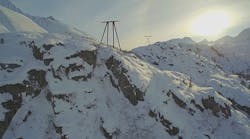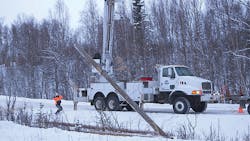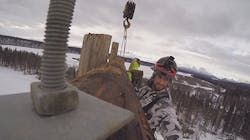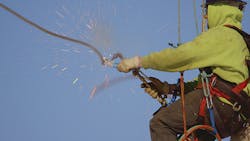In the heart of Alaska, power linemen brave subzero temperatures and high winds, avalanche warnings and storms that ravage the power grid. As such, television producers traveled to the last frontier during the dead of winter to film Alaskan linemen for the next “blue collar American hero job show.”
About two years ago, the History Channel turned to Tricon Films & Television to find a subject for a new reality series. After shadowing a line crew for a day, the producers were sold on the idea of profiling Alaskan power companies and hired Tricon to produce a new reality series called “Power & Ice,” says Jeff Hevert, an executive producer on the project and the senior vice president of U.S. development for Tricon Films & Television.
“In Alaska, they do everything from operating their own machinery to climbing poles,” says Hevert, who previously worked on reality television shows for MTV, E!, Bravo and other production companies. “They are like the special forces of the electrical trade. Because Alaska is the last frontier, and the grid is older and still expanding, there are so many lines under construction.”
“While many of today’s television shows are focusing on life off the grid, “Power & Ice” delves into what it takes to keep the lights and power on,” Hevert says. Because many Americans depend on the grid, the series has a central theme — without linemen working in severe weather and rough terrain, the nation wouldn’t have such a reliable power grid. He says that after the show finishes airing its first season, Americans will have a lot more respect for linemen, especially in Alaska. When temperatures plummet to -40°, homes can quickly drop to the same temperature. For that reason, Alaskan linemen work around the clock, on holidays and during double shifts to restore power.
“Whenever the power goes out, people are immediately shocked out of their complacency of having it, but they are respectful when the linemen get the job done and heat their house,” Hevert says. “Every time they flip the light switch or turn on the heater or their power goes out, people will know why their electricity is working and how it got to their homes,” he says.
Showing Real-Life Line Work
The series, which premiered on Aug. 27, profiles three key power companies in Alaska — City Electric in Anchorage, Electric Power Constructors (EPC) in Wasilla, and Alaskan Line Builders in Big Lake. While the three companies compete against one another for business, they all look out for one other.
“That’s one thing about linemen — everyone who is a lineman knows what it takes to do that job, and they all have a ton of respect for one another,” Hevert says.
While many of today’s reality shows are not as real as they seem and are completely scripted, “Power & Ice” portrayed real linemen doing actual work. To get a cross-section of footage from the different companies, Tricon assigned a separate production crew to each contractor. Because many of the linemen were working on or around energized lines, the crews also relied upon drone technology to obtain footage within hot zones.
“We got some amazing visuals of the live-line work,” Hevert says. “Each crew had its own drones, and we were able to get to places that we wouldn’t have been able to get to without them.”
In addition, the film crews had to prepare to travel long distances to film the crews in action. Unlike other shows in this genre, the production wasn’t self-contained to a limited area. For example, while one crew was working in the Thompson Pass and another contractor took on a project close to the Bering Sea.
“We had to be nimble and follow each other across the state, which was puzzling and challenging and made everything feel very, very real,” he says. “A few days before each show, our production team met with the crew foremen to learn what job was coming up next and where it was located. We could then start looking for certain story lines.”
From a production standpoint, filming the television show offered its share of challenges, Hevert says.
“The linemen weren’t used to talking about what they were doing, and it was difficult to get them to tell us,” he says. “Instead, we had to show the viewer what they do, but Alaska is a tough place to do anything. We were in some of the most remote, difficult places to work, and we covered about half of the state.”
Portraying Personalities
Throughout the eight episodes, the personality and the brand of the power contractors shines through, Hevert says. For example, City Electric is the oldest company in Alaska and relies on big machinery to get the job done. Meanwhile, Alaskan Line Builders treats every lineman as part of the family, while EPC is a younger company whose engineers think methodically through every project and rely on the latest technology to perform line work.
During the TV show, the crew focused on a few main characters per company — the owner, general foreman, foreman, lineman or apprentice.
“Everyone had big personalities and they were all very different,” he says. “Most of them also had nicknames.”
For example, Eric Nielson, the general foreman for City Electric, was called “Bam Bam,” and his right-hand man, Andy Korzeniewski, went by the name “Whiskey.” At Alaska Line Builders, the crew focused on a lifelong Alaskan lineman who had been in the trade for 40 years and wasn’t afraid of anything. For EPC, a younger company with younger linemen, Ben Miebs, a general foreman, was often in the spotlight. Miebs says it was very different to have cameras on the job site on the right-of-way.
“My main focus was for my guys to keep their focus on work and not the cameras,” Miebs says. “Also, we all tried to educate the public and the people a little about power line work and show the challenges of Alaska.
Miebs says he was happy with how EPC was portrayed on the show. “We’re a young company with a lot of eager journeymen, and we all have a strong love for the trade,” he says. “I hope this shows throughout the season.”
Confronting Challenges
While line work can be challenging and downright dangerous anywhere in the world, Alaska offered a unique set of obstacles, such as avalanche warnings in Thompson Pass.
“On the job they were doing, they were pulling out multi-ton towers out of the most avalanche ridden passes,” Hevert says. “As they were pulling out the towers, it would shift from 30° below to 30° above, which is very dangerous for avalanches. The crew and the linemen had daily avalanche meetings every morning to stay safe.”
Another high-stress job that the linemen worked on was on the island of Kodiak, Alaska. Because it rained and snowed during the same day, it caused muddy and wet conditions. In turn, the company needed to complete the final portion of the job with a helicopter and fly poles and materials from Anchorage to Kodiak, Alaska. The project was dangerous — for both the line and film crews alike.
“Because it was a warm winter, the bears were waking up early, and Kodiak is one of the most densely populated areas for bears,” he says. “We found bear hair and claw scratches, and when one of the linemen came around the corner, he saw a large male grizzly bear climbing up on his truck.”
In bear country, the linemen are used to seeing bears, and they came prepared. By firing a gun up into the air, they scared the bear, which ran away from the truck.
Continuing the Series
In addition to focusing on their life on the job, the production team also touched on their life outside of work. For example, they incorporated a few scenes with a wife and mother when a lineman lost his job and had to work on the North Slope.
“We talked about how this job takes a toll on families, and while they make a lot of money, it’s a risky job, and the wives have their husbands gone for long stretches of time,” Hevert says.
While Season 1 focused more on the job, the production team plans to dive more into the lives of linemen in the second season. The film crews may return to Alaska this winter, or they may opt to profile linemen in another location. Hevert says after spending time in Alaska profiling the linemen, he has a respect for the line crews.
“They are highly skilled, highly intelligent and technical workers, and what they are doing is very intricate,” he says. “They are tough, proud and smart to do such a difficult trade. When watching ‘Power & Ice,’ I think the viewers will also respect the amount of toughness and skill that they have.”
Editor’s note: To see full episodes of “Power & Ice,” visit the History Channel’s website at www.history.com. Also, to view an online photo gallery of photos of the Alaskan linemen at work, visit www.tdworld.com/electric-utility-operations.





